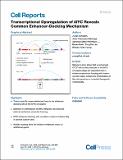| dc.contributor.author | Schuijers, Jurian | |
| dc.contributor.author | Day, Daniel Sindt | |
| dc.contributor.author | Hnisz, Denes | |
| dc.contributor.author | Lee, Tong Ihn | |
| dc.contributor.author | Manteiga, John Colonnese | |
| dc.contributor.author | Weintraub, Abraham Selby | |
| dc.contributor.author | Zamudio Montes de Oca, Alicia | |
| dc.contributor.author | Young, Richard A. | |
| dc.date.accessioned | 2018-07-23T16:50:12Z | |
| dc.date.available | 2018-07-23T16:50:12Z | |
| dc.date.issued | 2018-04 | |
| dc.date.submitted | 2018-02 | |
| dc.identifier.issn | 2211-1247 | |
| dc.identifier.uri | http://hdl.handle.net/1721.1/117042 | |
| dc.description.abstract | Transcriptional dysregulation of the MYC oncogene is among the most frequent events in aggressive tumor cells, and this is generally accomplished by acquisition of a super-enhancer somewhere within the 2.8 Mb TAD where MYC resides. We find that these diverse cancer-specific super-enhancers, differing in size and location, interact with the MYC gene through a common and conserved CTCF binding site located 2 kb upstream of the MYC promoter. Genetic perturbation of this enhancer-docking site in tumor cells reduces CTCF binding, super-enhancer interaction, MYC gene expression, and cell proliferation. CTCF binding is highly sensitive to DNA methylation, and this enhancer-docking site, which is hypomethylated in diverse cancers, can be inactivated through epigenetic editing with dCas9-DNMT. Similar enhancer-docking sites occur at other genes, including genes with prominent roles in multiple cancers, suggesting a mechanism by which tumor cell oncogenes can generally hijack enhancers. These results provide insights into mechanisms that allow a single target gene to be regulated by diverse enhancer elements in different cell types. | en_US |
| dc.description.sponsorship | National Institutes of Health (U.S.) (grant HG002668) | en_US |
| dc.description.sponsorship | Virginia and Daniel K. Ludwig Graduate Fellowship | en_US |
| dc.description.sponsorship | National Science Foundation (U.S.). Graduate Research Fellowship Program | en_US |
| dc.publisher | Elsevier | en_US |
| dc.relation.isversionof | http://dx.doi.org/10.1016/j.celrep.2018.03.056 | en_US |
| dc.rights | Creative Commons Attribution 4.0 International License | en_US |
| dc.rights.uri | http://creativecommons.org/licenses/by/4.0/ | en_US |
| dc.source | Elsevier | en_US |
| dc.title | Transcriptional Dysregulation of MYC Reveals Common Enhancer-Docking Mechanism | en_US |
| dc.type | Article | en_US |
| dc.identifier.citation | Schuijers, Jurian, John Colonnese Manteiga, Abraham Selby Weintraub, Daniel Sindt Day, Alicia Viridiana Zamudio, Denes Hnisz, Tong Ihn Lee, and Richard Allen Young. “Transcriptional Dysregulation of MYC Reveals Common Enhancer-Docking Mechanism.” Cell Reports 23, no. 2 (April 2018): 349–360. ª 2018 The Author(s). | en_US |
| dc.contributor.department | Massachusetts Institute of Technology. Department of Biology | en_US |
| dc.contributor.mitauthor | Manteiga, John Colonnese | |
| dc.contributor.mitauthor | Weintraub, Abraham Selby | |
| dc.contributor.mitauthor | Zamudio Montes de Oca, Alicia | |
| dc.contributor.mitauthor | Young, Richard A | |
| dc.relation.journal | Cell Reports | en_US |
| dc.eprint.version | Final published version | en_US |
| dc.type.uri | http://purl.org/eprint/type/JournalArticle | en_US |
| eprint.status | http://purl.org/eprint/status/PeerReviewed | en_US |
| dc.date.updated | 2018-07-13T16:56:18Z | |
| dspace.orderedauthors | Schuijers, Jurian; Manteiga, John Colonnese; Weintraub, Abraham Selby; Day, Daniel Sindt; Zamudio, Alicia Viridiana; Hnisz, Denes; Lee, Tong Ihn; Young, Richard Allen | en_US |
| dspace.embargo.terms | N | en_US |
| dc.identifier.orcid | https://orcid.org/0000-0002-0385-6176 | |
| dc.identifier.orcid | https://orcid.org/0000-0003-0998-9882 | |
| dc.identifier.orcid | https://orcid.org/0000-0001-6263-2423 | |
| dc.identifier.orcid | https://orcid.org/0000-0001-8855-8647 | |
| mit.license | PUBLISHER_CC | en_US |
